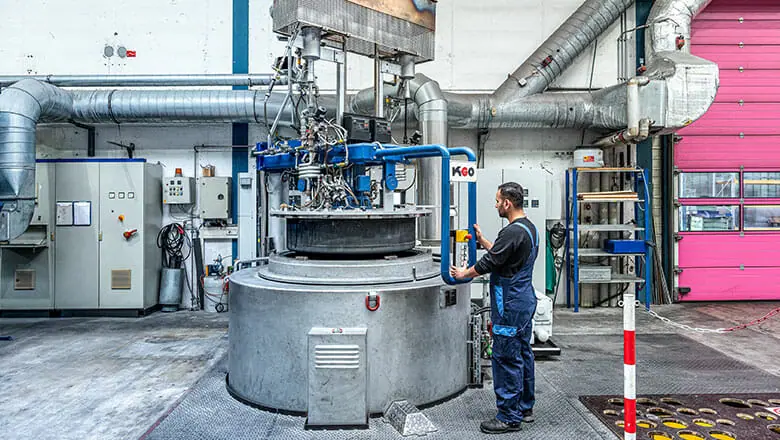Gas Nitriding
With gas nitriding, the edge of a workpiece is either finished with nitrogen or with nitrogen and carbon (gas nitrocarburising) in a gaseous atmosphere. To improve the tribological characteristics of the component, it can then be oxidised.
Advantages
- Improves resistance to wear and tear
- Increases tensile strength
- Increased compression strength
- Improved sliding properties
Materials
- Non- and low-alloy steels
- Case-hardening steels
- Tool steels
- Nitriding steels
Available plant sizes
- Length 5000 mm, diameter 980 mm

Typical values for nitriding
| DIN EN 10027-2 Material number | DIN EN 10027-2 (Short) designation | Surface Hardness in Vickers [HV0,5] | max. Nitriding hardness depth (NHD) [mm] |
|---|---|---|---|
| Carbon steel | |||
| 1.0060 | E335 | 280-500 | 0,6 |
| 1.0577 | S355 | 280-480 | 0,6 |
| 1.1191 | C 45 E | 300-500 | 0,7 |
| 1.1221 | C 60 E | 300-500 | 0,7 |
| 1.5122 | 37MnSi5 | 300-500 | 0,6 |
| Tempered steel | |||
| 1.0762 | 44SMn28 (ETG 100) | 400-500 | 0,3 |
| 1.7033 | 34Cr4 | 500-600 | 0,5 |
| 1.7220 | 34CrMo4 | 500-600 | 0,5 |
| 1.7225 / 1.7227 | 42CrMo4 / 42CrMoS4 | 550-700 | 0,5 |
| 1.8159 | 50CrV4 | 550-700 | 0,5 |
| 1.8161 | 58CrV4 | 550-700 | 0,5 |
| 1.6582 | 34CrNiMo6 | 600-800 | 0,5 |
| 1.2710 | 45NiCr6 | 600-750 | 0,4 |
| 1.2312 | 40CrMnMoS86 | 650-800 | 0,3 |
| Case-hardened steel | |||
| 1.7131 / 1.7139 | 16MnCr5 / 16MnCrS5 | 600-750 | 0,5 |
| 1.7147 | 20MnCr5 | 600-650 | 0,4 |
| 1.5752 | 14NiCr14 | 500-650 | 0,4 |
| Nitriding steel | |||
| 1.8504 | 34CrAl6 | 900-1200 | 0,4 |
| 1.8507 | 34CrAlMo5 | 900-1300 | 0,5 |
| 1.8519 | 31CrMoV9 | 780-900 | 0,5 |
| 1.8550 | 34CrAlNi7 | 900-1100 | 0,5 |
| Ball bearing steel | |||
| 1.3505 | 100Cr6 | 450-700 | 0,25 |
| 1.2510 | 100MnCrW4 | 500-700 | 0,25 |
| Grey cast iron — nodular cast iron | |||
| 0.6025 | EN-GJL-250 (GG 25) | 300-450 | 0,3 |
| 0.7080 | EN-GJS-600 (GGG 60) | 450-600 | 0,4 |
| Stainless steel | |||
| 1.4006 | X10Cr13 | 900-1100 | 0,1 |
| 1.4021 | X20Cr13 | 900-1200 | 0,1 |
| 1.4034 | X40Cr13 | 900-1200 | 0,1 |
| 1.4122 | X35CrBo17 | 1000-1250 | 0,15 |
| 1.4571 | X10CrNiMoTi1712-2 | 900-1150 | 0,1 |
| Cold work steel | |||
| 1.2379 | X155CrMoV121 | 900-1200 | 0,15 |
| 1.2080 | X210Cr12 | 850-1150 | 0,15 |
| 1.2364 | X100CrMoV51 | 1000-1200 | 0,2 |
| 1.2601 | X165CrMoV12 | 900-1150 | 0,15 |
| 1.2436 | X210CrV12 | 700-900 | 0,15 |
| Hot work steel | |||
| 1.2343 | X38CrMoV51 | 900-1150 | 0,4 |
| 1.2344 | X40CrMoV51 | 900-1150 | 0,4 |
| 1.2567 | X30WCrV53 | 850-1050 | 0,3 |
| 1.2365 | X32CrMoV33 | 750-900 | 0,3 |
| High Speed Steel (HSS) | |||
| All qualities | 950-1400 | 0,02-0,15 | |
The maximum hardness is determined by the material. All statements without guarantee.
Downloads
Want to read up a bit? Need details? No problem, simply download the information you need.
